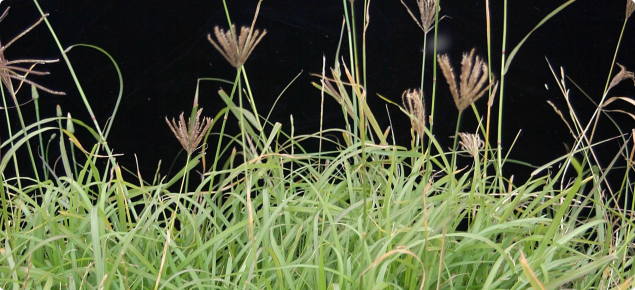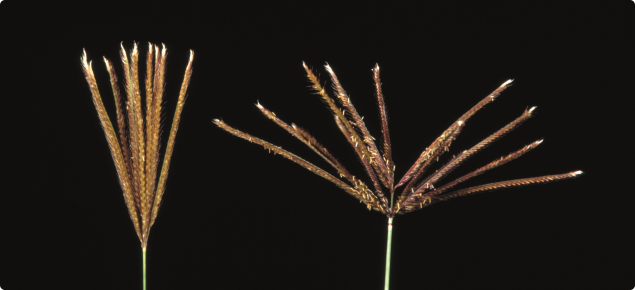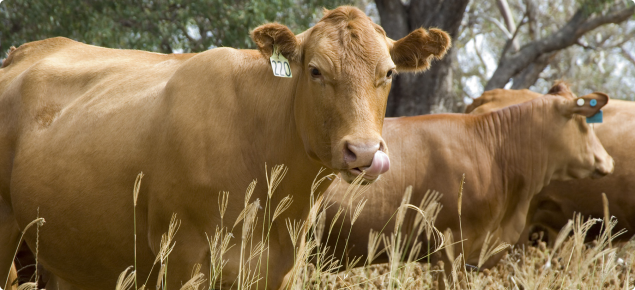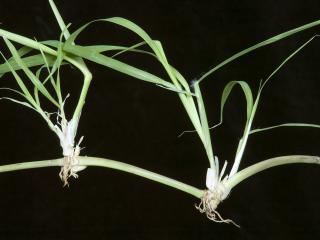Features
Rhodes grass (Chloris gayana) has the following features:
- a creeping perennial which spreads by stolons (runners)
- is adapted to a range of soil and climatic conditions
- is easy to establish with good seedling vigour
- has moderate to high drought tolerance
- has moderate feed quality and palatability
- may not persist under stressful conditions.
Rhodes grass is one of the main sub-tropical grasses used in agriculture and is widely grown in Africa, Australia, Japan, South America and under irrigation in the Middle East for both forage and soil conservation purposes. Rhodes grass is a morphologically variable out-crossing species, which is native to east, central and southern Africa where it occurs in open grasslands. It was introduced into Australia by soldiers returning from the Boer war, who brought with them the common variety (cv ‘Pioneer’).
In southern WA, Rhodes grass has been one of the most widely sown sub-tropical grasses in the last 10 years. It often dominates when sown in a mixture due to its good seedling vigour and ability to spread by runners. The longevity of stands under stressful conditions can be variable, as some Rhodes grass pastures only persist for 1–3 years, due to a combination of stresses including: low fertility, cold-wet soils, frost, over-grazing and competition from annual pastures.
Description
The morphology of Rhodes grass can be described as:
- a stoloniferous and tufted, leafy perennial grass
- with erect or ascending stems 0.5–2 metres (m) tall
- leaves are hairless and 15–50 centimetres (cm) long
- leaves on the stolons are shorter with 2–4 leaves per node
- brown, digitate seed head in the shape of an open hand.
Seasonal growth pattern
Rhodes grass grows actively following the opening rains in autumn until early June. It is generally dormant in winter, although it will continue to grow slowly in the northern agricultural region where winter temperatures are mild. It resumes active growth in early spring and grows opportunistically throughout summer depending on moisture availability.
Like most sub-tropical grasses, Rhodes grass prefers high temperatures with maximum growth at 30°C/25°C (day/night temperature) under controlled conditions. Growth is reduced greatly below 18°C/13°C and there is negligible growth when the average daily temperature is below 8°C.
| Rainfall (estimated minimum) | >425mm (>400mm south coast) |
|---|---|
| Drought tolerance | Moderate to high (depends on variety) |
| Frost tolerance | Low |
| Soil type | Range of medium- and coarse-textured soils |
| Soil fertility requirements | Favours more fertile soils in its natural habitat and is considered a ‘high fertility’ species. Very responsive to N fertiliser |
| Soil pHCa | >4.3 |
| Aluminium tolerance | Moderate |
| Waterlogging tolerance | Moderate |
| Salt tolerance | Slight (tetraploids) to moderately low (diploids). Has a number of mechanisms to deal with soil salinity including the ability to excrete sodium from salt glands on the leaves, accumulate salt in plant tissues and actively exclude salt from the roots |
| Ability to spread naturally | Very good from stolons |
| Dry matter digestibility | 61-65% (monthly cuts), 49-56% (when cut after 105-140 days) |
|---|---|
| Crude protein | 6.3% (unfertilised), 10.4-13.8% (low to high fertiliser N with monthly cuts) |
| Soil erosion control | Creeping habit provides good soil stabilisation |
|---|---|
| Weed control | Competes well with summer weeds |
Establishment
Rhodes grass is readily established from seed. The seed germinates quickly (1–7 days) depending on temperature. Rhodes grass displays good seedling vigour and often achieves full groundcover within three months of sowing. Rhodes grass has a high shoot/root ratio and a weak primary root system, so plants rely on developing a strong secondary root system and are easily pulled out by stock during the establishment period.
The suggested seeding rate is 2-5 kilograms/hectare (kg/ha) of good quality seed when sown alone or 1-3kg/ha when sown in a mixture (for coated seed use the higher seeding rates). The seed can be drilled at 5–10 millimetres (mm) followed by press wheels, or alternatively broadcast onto a firm, fine seed bed and then rolled to give good seed-soil contact. Rhodes grass seed is light and fluffy and as a result is difficult to handle, hence most seed is now sold in a coated form. For uncoated seed use a carrier to improve the flow through the seeder.
The optimum temperature for germination is 15–40°C, but a small proportion of seeds will germinate at lower temperatures. Unlike some sub-tropical grasses, Rhodes grass seeds germinate at low soil water contents and once germination has started it is irreversible. Under conditions of marginal soil moisture Rhodes grass may be the first species to germinate. Rhodes grass can compensate for poor seedling establishment by rapid stoloniferous growth to form a dense stand if it is carefully managed in the first two years.
Livestock disorders
None have been reported. Contains low levels of oxalate, so is not hazardous for horses.
Management
Premature grazing can severely damage a new Rhodes grass pasture as stock can up-root plants. Rhodes grass should not be grazed in the first year until the plants and runners are well anchored which may not occur until the autumn rains, as the stolons will only root into moist soils. Test the plants to see how well they are anchored before grazing.
Established stands can withstand periods of set-stocking, but heavy grazing can damage the stand. In more intensive systems, rotational grazing should result in higher production and better persistence.
In general, palatability is good but declines rapidly with maturity, so Rhodes grass should be grazed to prevent flowering. The digestibility of Rhodes grass varies widely, but is generally similar to other sub-tropical grasses at an equivalent growth stage.
Rhodes grass can survive fire, although hot fires can kill the small plants growing on stolon nodes.
Companion species
Rhodes grass can be grown with annual legumes like subterranean clover, burr medic and serradella on sandy, well-drained soils, or subterranean clover, balansa clover and slender serradella on winter-waterlogged soils. Graze the sward hard in late autumn to give the annual legumes an opportunity to establish.
Rhodes grass can be sown as a monoculture, but is usually sown in a mix with bunch grasses like panic grass. Rhodes grass can dominate when sown in a mixture due to its good seedling vigour and its ability to spread by runners. When sown as part of a mix, it will typically be the most productive species in the first two years.
Cultivars
There are a large number of Rhodes grass varieties and these can be separated in two main groups – diploid and tetraploid types – the latter having double the number of chromosomes.
Diploid types
These come from sub-tropical regions, are more robust and flower over a wide period as the flowering response is insensitive to day length. In general, they have superior frost tolerance, salt tolerance and drought tolerance than the tetraploid types.
‘Pioneer’ or common (public variety) is quite variable but is characterised as an early flowering, erect plant with moderate leafiness. It is widely naturalised in sub-tropical eastern Australia, but has been superseded by newer varieties.
‘Topcut’ (Plant Breeder's Rights - PBR) is a selection from Pioneer developed primarily for hay production, which is reported to be leafier, finer-stemmed and produce more dry matter.
'Salcut' (PBR) is a selection from Topcut Rhodes grass for improved plant growth and survival under saline conditions and then improved agronomic characteristics (fine stems, leafy growth habit).
‘Katambora’ (public variety) is mid-flowering and is characterised by strong stolon development, heavy seeding and drought tolerance. In Queensland, it is more persistent on low fertility soils than other cultivars.
‘Nemkat’ (public variety) is a selection from Katambora that has resistance to all the known root-knot nematodes in the north-Queensland tobacco growing areas. ‘Nemkat’ has had limited testing in WA.
‘Finecut’ (PBR) is a selection from Katambora developed primarily for hay production and is reported to be leafier, finer-stemmed and to produce more dry matter in Queensland.
'Gulfcut' (PBR) is a selection from Finecut Rhodes grass for improved plant growth and survival under saline conditions and then improved agronomic characteristics (fine stems, leafy growth habit).
'Reclaimer' (PBR) is a selection from Finecut Rhodes grass for improved plant growth and survival under saline conditions and then improved agronomic characteristics (fine stems, leafy growth habit).
'KG2' (PBR) and 'KP8' (PBR) are both selections from KP4 Rhodes grass for improved germination, growth and survival under saline conditions and then improved agronomic characteristics (late flowering, prostrate growth habit and stoloniferous growth).
Tetraploid (giant) types
Late flowering types from tropical regions that are tall (>1.8m) and have coarse leaves, stems and stolons. They are strongly stoloniferous, leafy, late flowering, drought-tolerant and have high dry matter production. Their main advantage is that they only flower late in the season (as they flower in response to short-day lengths), so feed quality is maintained for longer. However, when grown under optimal conditions and grazed regularly there is little if any difference in the animal intake or the digestibility of different types of Rhodes grass.
‘Callide’ (public variety) an introduction from Tanzania is widely grown in Australia.
'Sabre' (PBR) is a selection from 'Callide' Rhodes grass for improved germination, growth and survival under saline conditions and then improved agronomic characteristics (early flowering, leafy growth habit).
'Toro' (PBR) is a selection from 'Callide' Rhodes grass for improved germination, growth and survival under saline conditions and then improved agronomic characteristics (late flowering, leafy growth habit).
'Mariner' (PBR) is a selection from 'Samford' Rhodes grass for improved germination, growth and survival under saline conditions and then improved agronomic characteristics (late flowering, leafy growth habit).
It should be noted that the ‘salt tolerant’ Rhodes grass varieties that have recently become available were specifically developed for irrigation with brackish water and may not have the combination of salt and waterlogging tolerance required for most saline sites in the agricultural areas of WA.




